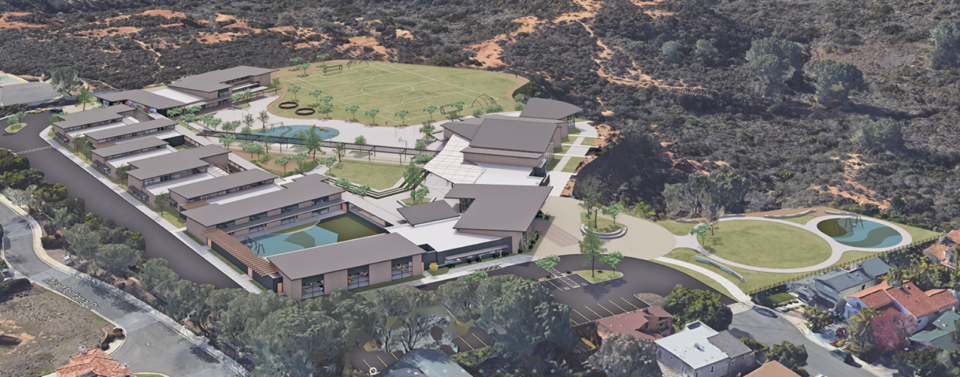DEL MAR — Come 2021, Del Mar Heights School will see a complete rebuild of its 61-year-old campus.
The Del Mar Union School District Board of Trustees unanimously approved a redesign of the elementary school at a May 12 virtual meeting — the long-awaited green light to a project at least six years in the making.
The approved rebuild will get rid of the campus’ infamous, decaying portable classrooms, about double the school’s queuing area and parking spaces, and create integrated indoor/outdoor learning spaces for the school’s approximately 500 students.
The redesign has endured its fair share of hurdles, demonstrated by the over two hours of divisive public comment leading up to its approval.
Plenty of parents, teachers, and even students chimed in to push the district onward, supporting the new design.
“Our new school plan is a balance of everything we asked for,” said longtime Del Mar Heights teacher Paige Rollins. “It’s an inspiring place for children, teachers and our community.”
But a near equal number of community members and parents spoke out against the project. Their numbers have grown over the months, though opposition first began in the fall, with concerns over the design’s decreased field size.
The discussion has since yielded a multifaceted debate over defensible space, fire evacuation plans, the school’s student capacity and air pollution on campus from the incorporated queueing space.
The $45 million project has been on the school district’s radar for years. As the oldest school in the district, a pre-COVID-19 Del Mar Heights was operating well beyond its capacity. A third of the classrooms were situated in portable structures that in some cases had been condemned, overrun by animals or plagued with mold.
The passage of Measure MM in 2018 cleared the way for a rebuild. The voter-approved bond measure allowed the district to secure funding for major school revitalization projects, the Del Mar Heights rebuild being at the top of the list.
Throughout 2019, architects with BakerNowicki Design Studio conducted workshops to gather input from parents, faculty and students on what a new school should look like. Many teachers and faculty were happy with the outcome, but others were shaken by the sizable decrease in the school’s field size.

Such concerns prompted the formation of two nonprofit organizations — Save the Field and Play Outside Del Mar, and a petition with over 2,000 signatures calling for the field’s preservation.
The architects increased the size of the redesign’s field twice to accommodate these concerns — with the site’s total green space ultimately seeing an increase of about 1,500 square feet. But the main green field will still be smaller than before.
A few parents spoke at the meeting to lament what they saw as a prioritization of parking at the expense of a larger field.
“I think the school should slow down and do better for the community, do better for the kids by coming up with a better plan — one that doesn’t sacrifice the field for a road so people can park,” said parent Garrett Anderson.
When the district released the project’s mitigated negative declaration (MND) in February, such opposition only escalated. Required for a school project such as this, the California Environmental Quality Act (CEQA) document is meant to show how the district can mitigate certain impacts of a project to a level of insignificance.
But many saw this environmental review process as insufficient, particularly due to the school’s proximity to the Torrey Pines State Reserve and associated risks of wildfire exposure.
In response to the MND, Procopio law firm prepared a lengthy comment on behalf of Save the Field — leading to concerns about potential litigation.
The letter asserts that the district’s MND inadequately anticipates impacts related to community park space, biological resources and fire protection — to name a few.
Wendy Wiles, an attorney for the district, said that a potential lawsuit would address whether the district should have gone forward with an environmental impact report — a more rigorous document that assumes a project will indeed have significant impacts on the surrounding environment.
But according to Wiles, concerns raised by residents never quite reached that CEQA bar of “significance.”
“The project has mitigated any of the potentially significant effects, and there is no substantial evidence that the project will have a significant effect on the environment,” she said.
In its letter, Procopio argued that the district should have completed a wildfire evacuation study as part of its review process — adding that evacuation may take longer because many of the new classrooms will be closer to the southern portion of campus — away from the entrance at its northern edge.
Several speakers at the May meeting concurred.
Diane Nygaard, co-chair of the North County Sierra Club’s conservation committee, called such a study a “common-sense investment in safety.”
“It helps first responders come up with a meaningful evacuation plan, making the school and the entire neighborhood safer,” she said during the May meeting. “All we ask is for you to do this study, and complete it before the school is occupied.”
The district has been working with consultant Dwayne Mears to respond to some of the community’s main concerns with the MND — a move that was not required as part of the district’s environmental review process.
Mears’ review concluded that the project is “an improvement over the current condition.”
“You’re reducing congestion, you’re providing better fire lanes, you’re providing better access through the drop-off zone so that if there is a real emergency, you have the potential to get in with emergency vehicles, and you have greater ability to evacuate the site as well,” Mears said.
The project, which was preapproved by the City of San Diego Fire Marshal, would move classrooms at least 25 feet away from the edge of the canyon, and provide a 20-foot-wide fire lane at the campus’s entrance, compared with the 10-foot-wide lane that exists now.
At the meeting, the project’s supporters argued that further environmental review would only cause delay and drain school district funds and likely not result in an improved project.
“If we had to design the school 1,000 different times, it would be identical to this,” said parent Mike Milligan.
With the project now approved, the redesign awaits final review by the Division of the State Architect before going out to bid. According to district staff, the project could break ground as early as late June.
Pending the realities of the COVID-19 pandemic, the new school is anticipated to open in the fall of 2021.



